Abstract
Combination effects of recombinant human interleukin-1 alpha with ceftazidime, moxalactam, gentamicin, enoxacin, amphotericin B, miconazole, or an immunoglobulin preparation were evaluated in systemic infections with Pseudomonas aeruginosa, Klebsiella pneumoniae, and Candida albicans in normal mice and systemic infection with P. aeruginosa in mice with leukopenia induced by preadministration of cyclophosphamide. Synergistic effects were generally observed at interleukin-1 alpha doses as low as 1 to 30 ng per mouse with most combinations. The results show the possibility that recombinant human interleukin-1 alpha could be of help for treating obstinate infections not successfully treated with antimicrobial agents alone.
Full text
PDF
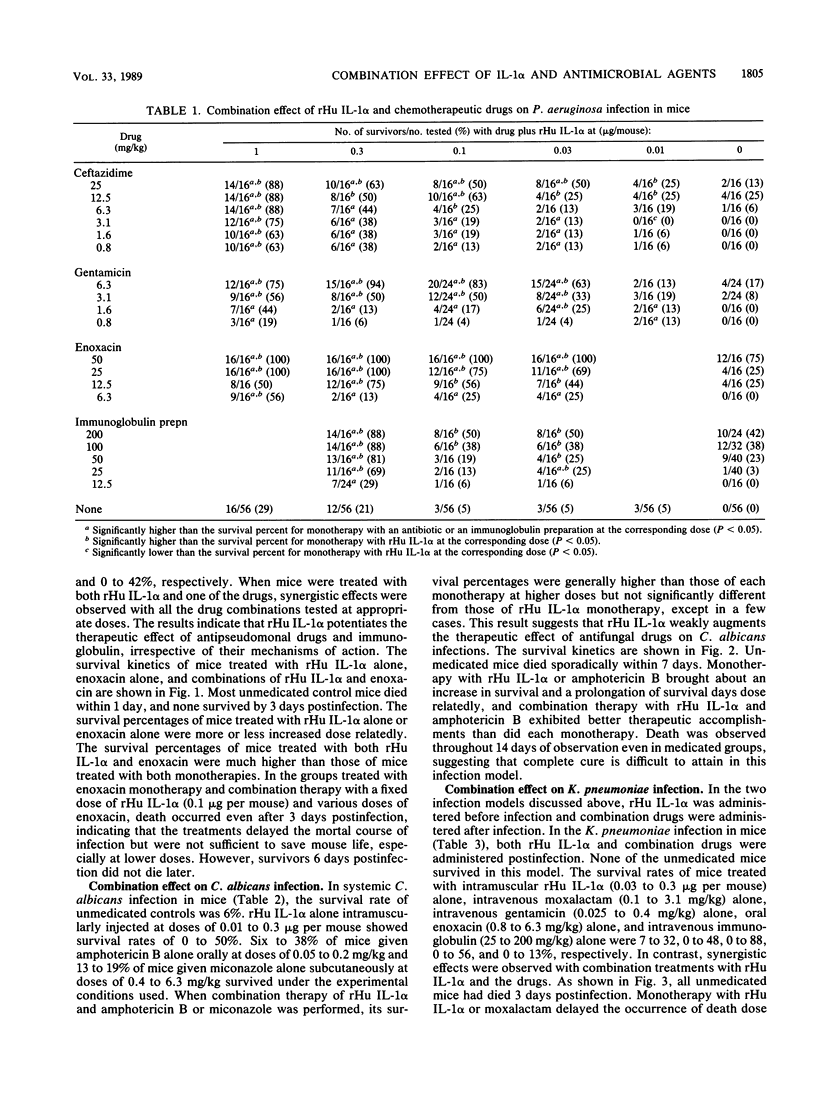
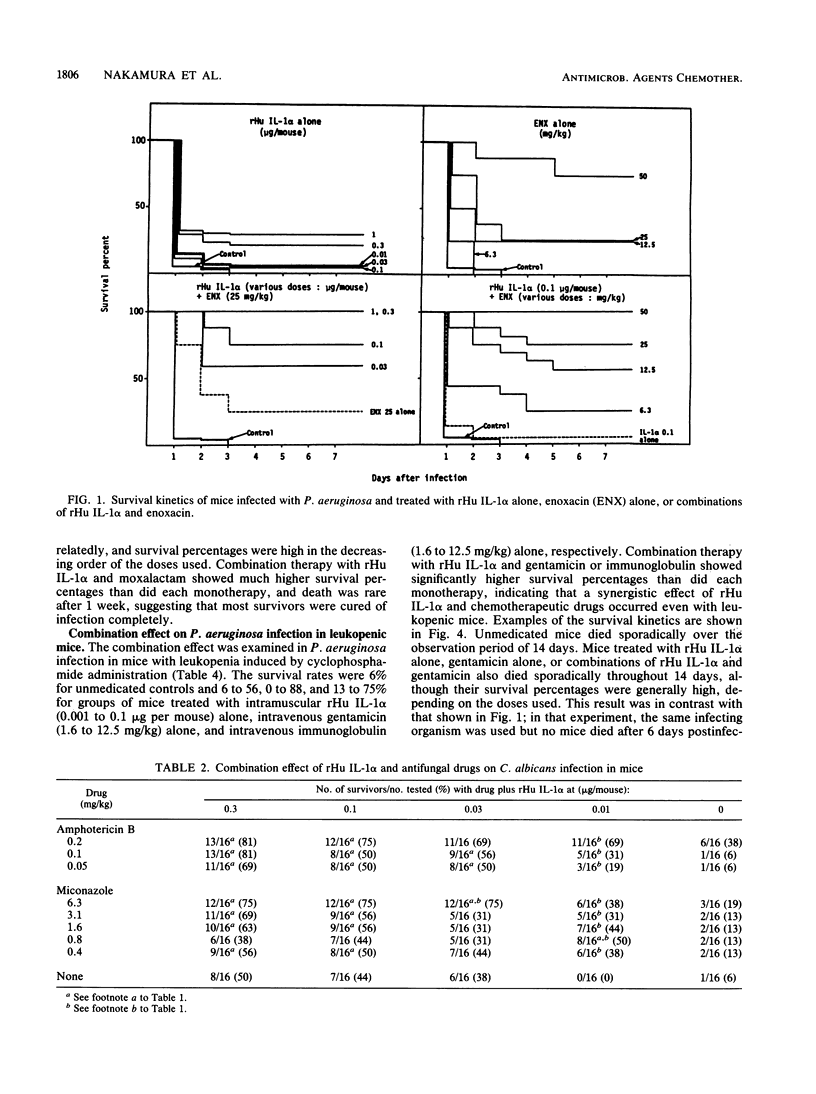
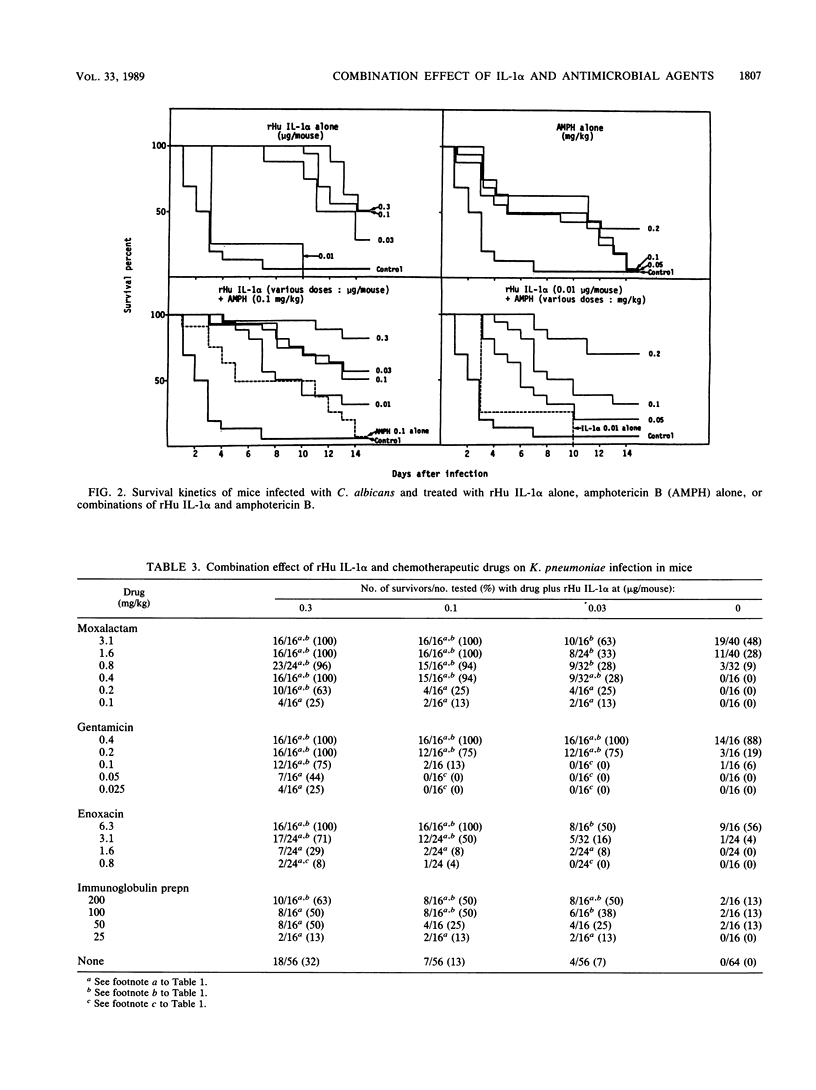
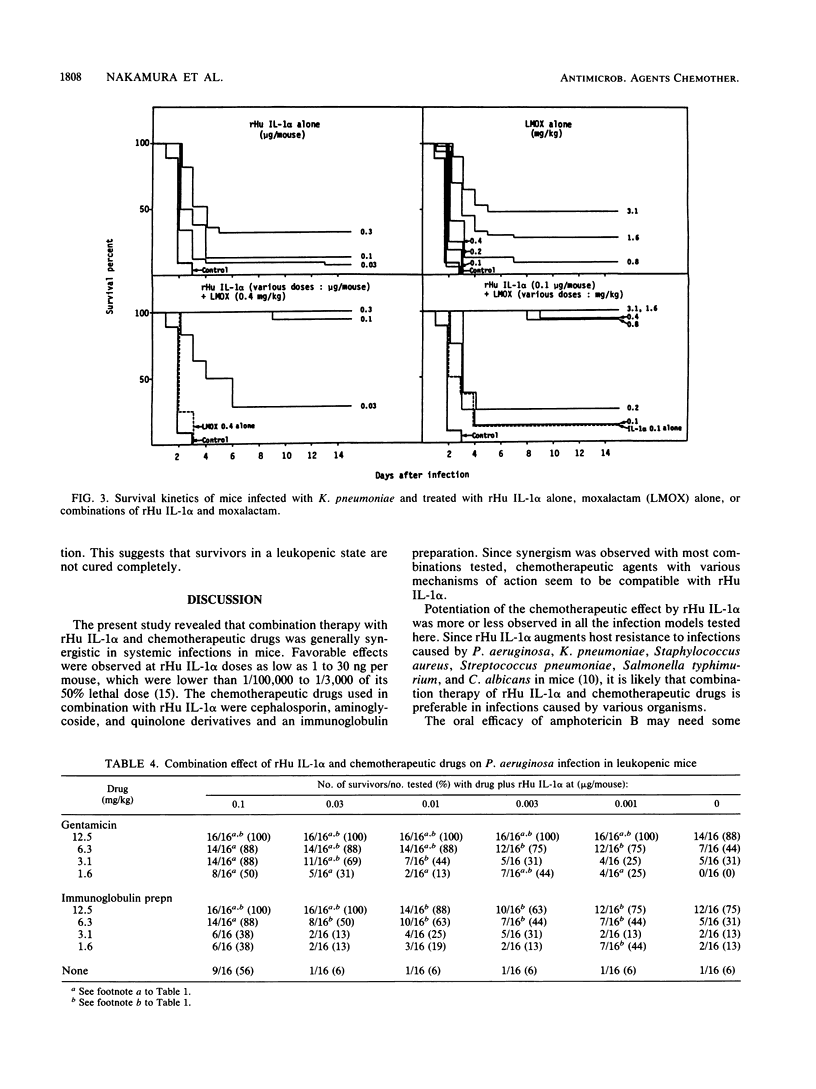
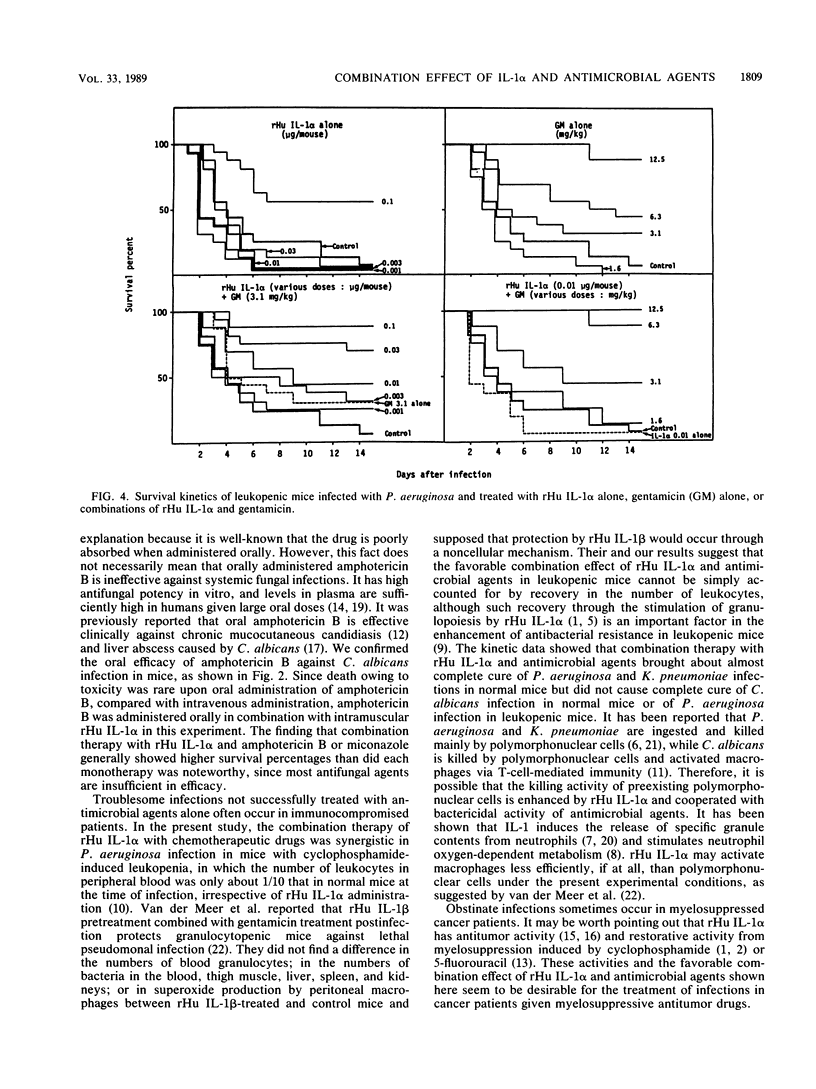
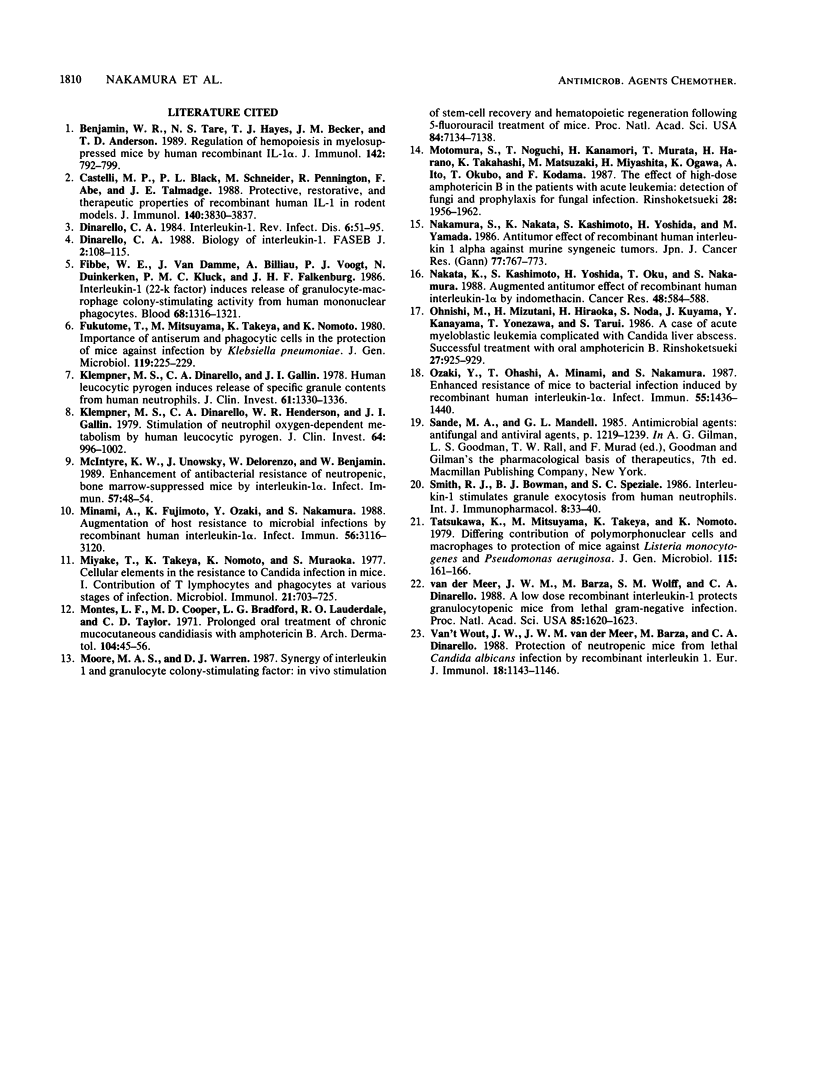
Selected References
These references are in PubMed. This may not be the complete list of references from this article.
- Benjamin W. R., Tare N. S., Hayes T. J., Becker J. M., Anderson T. D. Regulation of hemopoiesis in myelosuppressed mice by human recombinant IL-1 alpha. J Immunol. 1989 Feb 1;142(3):792–799. [PubMed] [Google Scholar]
- Castelli M. P., Black P. L., Schneider M., Pennington R., Abe F., Talmadge J. E. Protective, restorative, and therapeutic properties of recombinant human IL-1 in rodent models. J Immunol. 1988 Jun 1;140(11):3830–3837. [PubMed] [Google Scholar]
- Dinarello C. A. Biology of interleukin 1. FASEB J. 1988 Feb;2(2):108–115. [PubMed] [Google Scholar]
- Dinarello C. A. Interleukin-1. Rev Infect Dis. 1984 Jan-Feb;6(1):51–95. doi: 10.1093/clinids/6.1.51. [DOI] [PubMed] [Google Scholar]
- Fibbe W. E., van Damme J., Billiau A., Voogt P. J., Duinkerken N., Kluck P. M., Falkenburg J. H. Interleukin-1 (22-K factor) induces release of granulocyte-macrophage colony-stimulating activity from human mononuclear phagocytes. Blood. 1986 Dec;68(6):1316–1321. [PubMed] [Google Scholar]
- Fukutome T., Mitsuyama M., Takeya K., Nomoto K. Importance of antiserum and phagocytic cells in the protection of mice against infection by Klebsiella pneumoniae. J Gen Microbiol. 1980 Jul;119(1):225–229. doi: 10.1099/00221287-119-1-225. [DOI] [PubMed] [Google Scholar]
- Klempner M. S., Dinarello C. A., Gallin J. I. Human leukocytic pyrogen induces release of specific granule contents from human neutrophils. J Clin Invest. 1978 May;61(5):1330–1336. doi: 10.1172/JCI109050. [DOI] [PMC free article] [PubMed] [Google Scholar]
- Klempner M. S., Dinarello C. A., Henderson W. R., Gallin J. I. Stimulation of neutrophil oxygen-dependent metabolism by human leukocytic pyrogen. J Clin Invest. 1979 Oct;64(4):996–1002. doi: 10.1172/JCI109566. [DOI] [PMC free article] [PubMed] [Google Scholar]
- McIntyre K. W., Unowsky J., DeLorenzo W., Benjamin W. Enhancement of antibacterial resistance of neutropenic, bone marrow-suppressed mice by interleukin-1 alpha. Infect Immun. 1989 Jan;57(1):48–54. doi: 10.1128/iai.57.1.48-54.1989. [DOI] [PMC free article] [PubMed] [Google Scholar]
- Minami A., Fujimoto K., Ozaki Y., Nakamura S. Augmentation of host resistance to microbial infections by recombinant human interleukin-1 alpha. Infect Immun. 1988 Dec;56(12):3116–3120. doi: 10.1128/iai.56.12.3116-3120.1988. [DOI] [PMC free article] [PubMed] [Google Scholar]
- Miyake T., Takeya K., Nomoto K., Muraoka S. Cellular elements in the resistance to candida infection in mice. I. Contribution of T lymphocytes and phagocytes at various stages of infection. Microbiol Immunol. 1977;21(12):703–725. doi: 10.1111/j.1348-0421.1977.tb00339.x. [DOI] [PubMed] [Google Scholar]
- Montes L. F., Cooper M. D., Bradford L. G., Lauderdale R. O., Taylor C. D. Prolonged oral treatment of chronic mucocutaneous candidiasis with Amphotericin B. Arch Dermatol. 1971 Jul;104(1):45–56. [PubMed] [Google Scholar]
- Moore M. A., Warren D. J. Synergy of interleukin 1 and granulocyte colony-stimulating factor: in vivo stimulation of stem-cell recovery and hematopoietic regeneration following 5-fluorouracil treatment of mice. Proc Natl Acad Sci U S A. 1987 Oct;84(20):7134–7138. doi: 10.1073/pnas.84.20.7134. [DOI] [PMC free article] [PubMed] [Google Scholar]
- Motomura S., Noguchi T., Kanamori H., Murata T., Harano H., Takahashi K., Matsuzaki M., Miyashita H., Ogawa K., Ito A. [The effect of oral high-dose amphotericin B in patients with acute leukemia: detection of fungi and prophylaxis for fungal infection]. Rinsho Ketsueki. 1987 Nov;28(11):1956–1962. [PubMed] [Google Scholar]
- Nakamura S., Nakata K., Kashimoto S., Yoshida H., Yamada M. Antitumor effect of recombinant human interleukin 1 alpha against murine syngeneic tumors. Jpn J Cancer Res. 1986 Aug;77(8):767–773. [PubMed] [Google Scholar]
- Nakata K., Kashimoto S., Yoshida H., Oku T., Nakamura S. Augmented antitumor effect of recombinant human interleukin-1 alpha by indomethacin. Cancer Res. 1988 Feb 1;48(3):584–588. [PubMed] [Google Scholar]
- Ohnishi M., Mizutani H., Hiraoka H., Noda S., Kuyama J., Kanayama Y., Yonezawa T., Tarui S. [A case of acute myeloblastic leukemia complicated with Candida liver abscess. A successful treatment with oral amphotericin B]. Rinsho Ketsueki. 1986 Jun;27(6):925–929. [PubMed] [Google Scholar]
- Ozaki Y., Ohashi T., Minami A., Nakamura S. Enhanced resistance of mice to bacterial infection induced by recombinant human interleukin-1a. Infect Immun. 1987 Jun;55(6):1436–1440. doi: 10.1128/iai.55.6.1436-1440.1987. [DOI] [PMC free article] [PubMed] [Google Scholar]
- Smith R. J., Bowman B. J., Speziale S. C. Interleukin-1 stimulates granule exocytosis from human neutrophils. Int J Immunopharmacol. 1986;8(1):33–40. doi: 10.1016/0192-0561(86)90070-6. [DOI] [PubMed] [Google Scholar]
- Tatsukawa K., Mitsuyama M., Takeya K., Nomoto K. Differing contribution of polymorphonuclear cells and macrophages to protection of mice against Listeria monocytogenes and Pseudomonas aeruginosa. J Gen Microbiol. 1979 Nov;115(1):161–166. doi: 10.1099/00221287-115-1-161. [DOI] [PubMed] [Google Scholar]
- Van't Wout J. W., Van der Meer J. W., Barza M., Dinarello C. A. Protection of neutropenic mice from lethal Candida albicans infection by recombinant interleukin 1. Eur J Immunol. 1988 Jul;18(7):1143–1146. doi: 10.1002/eji.1830180728. [DOI] [PubMed] [Google Scholar]
- van der Meer J. W., Barza M., Wolff S. M., Dinarello C. A. A low dose of recombinant interleukin 1 protects granulocytopenic mice from lethal gram-negative infection. Proc Natl Acad Sci U S A. 1988 Mar;85(5):1620–1623. doi: 10.1073/pnas.85.5.1620. [DOI] [PMC free article] [PubMed] [Google Scholar]


